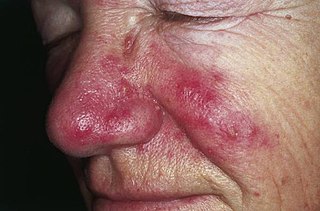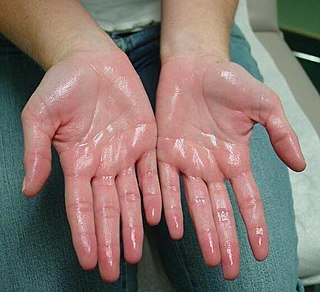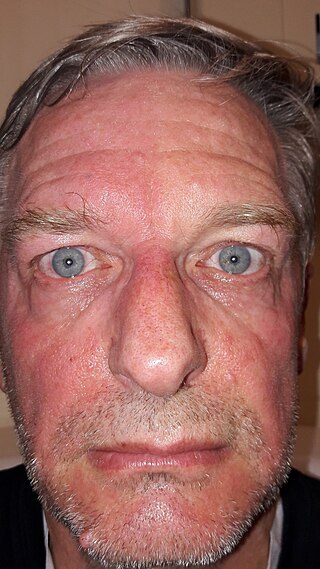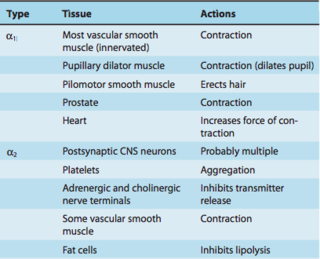
Beta blockers, also spelled β-blockers, are a class of medications that are predominantly used to manage abnormal heart rhythms (arrhythmia), and to protect the heart from a second heart attack after a first heart attack. They are also widely used to treat high blood pressure, although they are no longer the first choice for initial treatment of most people.

Propranolol is a medication of the beta blocker class. It is used to treat high blood pressure, some types of irregular heart rate, thyrotoxicosis, capillary hemangiomas, akathisia, performance anxiety, and essential tremors, as well to prevent migraine headaches, and to prevent further heart problems in those with angina or previous heart attacks. It can be taken orally or by intravenous injection. The formulation that is taken orally comes in short-acting and long-acting versions. Propranolol appears in the blood after 30 minutes and has a maximum effect between 60 and 90 minutes when taken orally.

Atenolol is a beta blocker medication primarily used to treat high blood pressure and heart-associated chest pain. Although used to treat high blood pressure, it does not seem to improve mortality in those with the condition. Other uses include the prevention of migraines and treatment of certain irregular heart beats. It is taken orally or by intravenous injection. It can also be used with other blood pressure medications.

Rosacea is a long-term skin condition that typically affects the face. It results in redness, pimples, swelling, and small and superficial dilated blood vessels. Often, the nose, cheeks, forehead, and chin are most involved. A red, enlarged nose may occur in severe disease, a condition known as rhinophyma.

Hyperhidrosis is a medical condition in which a person exhibits excessive sweating, more than is required for the regulation of body temperature. Although it is primarily a physical burden, hyperhidrosis can deteriorate the quality of life of the people who are affected from a psychological, emotional, and social perspective. In fact, hyperhidrosis almost always leads to psychological as well as physical and social consequences. People suffering from it present difficulties in professional fields, more than 80% experiencing a moderate to severe emotional impact from the disease and half are subject to depression.
Endoscopic thoracic sympathectomy (ETS) is a surgical procedure in which a portion of the sympathetic nerve trunk in the thoracic region is destroyed. ETS is used to treat excessive sweating in certain parts of the body, facial flushing, Raynaud's disease and reflex sympathetic dystrophy. By far the most common complaint treated with ETS is sweaty palms. The intervention is controversial and illegal in some jurisdictions. Like any surgical procedure, it has risks; the endoscopic sympathetic block (ESB) procedure and those procedures that affect fewer nerves have lower risks.

Phenylephrine, sold under the brand names Neosynephrine and Sudafed PE among others, is a medication used as a decongestant for uncomplicated nasal congestion in the form of a nasal spray or oral tablet, to dilate the pupil, to increase blood pressure given intravenously in cases of low blood pressure, and to relieve hemorrhoids as a suppository. It can also be applied to the skin.

Oxymetazoline, sold under the brand name Afrin among others, is a topical decongestant and vasoconstrictor medication. It is available over-the-counter as a nasal spray to treat nasal congestion and nosebleeds, as eye drops to treat eye redness due to minor irritation, and as a prescription topical cream to treat persistent facial redness due to rosacea in adults. Its effects begin within minutes and last for up to six hours. Intranasal use for longer than three to five days may cause congestion to recur or worsen, resulting in physical dependence.

Isoprenaline, also known as isoproterenol and sold under the brand name Isuprel among others, is a sympathomimetic medication which is used in the treatment of acute bradycardia, heart block, and rarely for asthma, among other indications. It is used by injection into a vein, muscle, fat, or the heart, by inhalation, and in the past under the tongue or into the rectum.

Harlequin syndrome, also known as "harlequin sign", is a condition characterized by asymmetric sweating and flushing on the upper thoracic region of the chest, neck and face. Harlequin syndrome is considered an injury to the autonomic nervous system (ANS). The ANS controls some of the body's natural processes such as sweating, skin flushing and pupil response to stimuli. Individuals with this syndrome have an absence of sweat skin flushing unilaterally, usually on one side of the face, arms and chest. It is an autonomic disorder that may occur at any age.

Labetalol is a medication used to treat high blood pressure and in long term management of angina. This includes essential hypertension, hypertensive emergencies, and hypertension of pregnancy. In essential hypertension it is generally less preferred than a number of other blood pressure medications. It can be given by mouth or by injection into a vein.

Compensatory hyperhidrosis is a form of neuropathy. It is encountered in patients with myelopathy, thoracic disease, cerebrovascular disease, nerve trauma or after surgeries. The exact mechanism of the phenomenon is poorly understood. It is attributed to the perception in the hypothalamus (brain) that the body temperature is too high. The sweating is induced to reduce body heat.

The alpha-2 (α2) adrenergic receptor is a G protein-coupled receptor (GPCR) associated with the Gi heterotrimeric G-protein. It consists of three highly homologous subtypes, including α2A-, α2B-, and α2C-adrenergic. Some species other than humans express a fourth α2D-adrenergic receptor as well. Catecholamines like norepinephrine (noradrenaline) and epinephrine (adrenaline) signal through the α2-adrenergic receptor in the central and peripheral nervous systems.

An adrenergic antagonist is a drug that inhibits the function of adrenergic receptors. There are five adrenergic receptors, which are divided into two groups. The first group of receptors are the beta (β) adrenergic receptors. There are β1, β2, and β3 receptors. The second group contains the alpha (α) adrenoreceptors. There are only α1 and α2 receptors. Adrenergic receptors are located near the heart, kidneys, lungs, and gastrointestinal tract. There are also α-adreno receptors that are located on vascular smooth muscle.

Adrenaline, also known as epinephrine, is a hormone and medication which is involved in regulating visceral functions. It appears as a white microcrystalline granule. Adrenaline is normally produced by the adrenal glands and by a small number of neurons in the medulla oblongata. It plays an essential role in the fight-or-flight response by increasing blood flow to muscles, heart output by acting on the SA node, pupil dilation response, and blood sugar level. It does this by binding to alpha and beta receptors. It is found in many animals, including humans, and some single-celled organisms. It has also been isolated from the plant Scoparia dulcis found in Northern Vietnam.

Alpha blockers, also known as α-blockers or α-adrenoreceptor antagonists, are a class of pharmacological agents that act as antagonists on α-adrenergic receptors (α-adrenoceptors).

Cocaine intoxication refers to the subjective, desired and adverse effects of cocaine on the mind and behavior of users. Both self-induced and involuntary cocaine intoxication have medical and legal implications.

The catecholamines are a group of neurotransmitters composed of the endogenous substances dopamine, noradrenaline (norepinephrine), and adrenaline (epinephrine), as well as numerous artificially synthesized compounds such as isoprenaline - an anti-bradycardiac medication. Their investigation constitutes a major chapter in the history of physiology, biochemistry, and pharmacology. Adrenaline was the first hormone extracted from an endocrine gland and obtained in pure form, before the word hormone was coined. Adrenaline was also the first hormone whose structure and biosynthesis was discovered. Second to acetylcholine, adrenaline and noradrenaline were some of the first neurotransmitters discovered, and the first intercellular biochemical signals to be found in intracellular vesicles. The β-adrenoceptor gene was the first G protein-coupled receptor to be cloned.

Serafim Guimarães, full name Serafim Correia Pinto Guimarães, is a Portuguese physician and pharmacologist. With his colleague Walter Osswald he made the Department of Pharmacology, Medical Faculty of the University of Porto, a center of research on catecholamines and the sympathetic nervous system, especially their relation to blood vessels.
Adrenergic blocking agents are a class of drugs that exhibit its pharmacological action through inhibiting the action of the sympathetic nervous system in the body. The sympathetic nervous system(SNS) is an autonomic nervous system that we cannot control by will. It triggers a series of responses after the body releases chemicals named noradrenaline and epinephrine. These chemicals will act on adrenergic receptors, with subtypes Alpha-1, Alpha-2, Beta-1, Beta-2, Beta-3, which ultimately allow the body to trigger a "fight-or-flight" response to handle external stress. These responses include vessel constriction in general vessels whereas there is vasodilation in vessels that supply skeletal muscles or in coronary vessels. Additionally, the heart rate and contractile force increase when SNS is activated, which may be harmful to cardiac function as it increases metabolic demand.


















